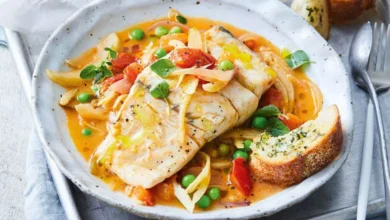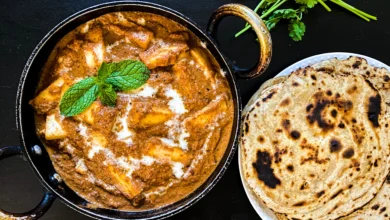Masala Dosa Recipe
Masala Dosa Recipe

Masala Dosa Recipe Introduction:
Masala Dosa is a quintessential part of South Indian cuisine, known for its delightful contrast between the crispy dosa (a thin, savory pancake made from fermented rice and lentil batter) and the soft, spiced potato filling. It’s typically served with coconut chutney and sambar, a tangy lentil soup, making it a well-rounded and satisfying meal.
The dosa itself is made from a fermented batter of rice and urad dal (black gram), which gives it a distinct, slightly sour flavor and crispy texture. The filling, called “masala,” is a spiced mixture of mashed potatoes, onions, and various aromatic spices, creating a harmonious blend of flavors.
Masala Dosa Recipe Overview:
Masala dosa is a popular South Indian dish featuring a crispy, thin rice and lentil crepe (dosa) filled with a spiced potato mixture.

Masala Dosa Recipe Ingredients:
Dosa Batter Ingredients
- Rice: 1 cup
- Urad dal (split black gram): 1/4 cup
- Chana dal (split chickpeas): 1 tbsp
- Fenugreek seeds: 1/2 tsp
- Water: as needed
- Salt: to taste
Masala Filling Ingredients
- Potatoes: 4-5 medium, boiled and mashed
- Onion: 1 large, finely chopped
- Green chilies: 2, finely chopped
- Ginger: 1-inch piece, grated
- Mustard seeds: 1 tsp
- Cumin seeds: 1 tsp
- Turmeric powder: 1/2 tsp
- Coriander powder: 1 tsp
- Garam masala: 1/2 tsp
- Curry leaves: a few
- Oil: 2 tbsp (for cooking the masala)
- Salt: to taste
- Coriander leaves: a handful, chopped (for garnish)
Optional Ingredients (for serving)
- Coconut chutney: as desired
- Sambar: as desired
These ingredients will help you create a delicious masala dosa with a crispy texture and a flavorful potato filling.
Masala Dosa Recipe Ingredient Tips:
Dosa Batter Ingredients
- Rice: Use regular white rice, not parboiled or basmati rice. Basmati rice can be too aromatic and doesn’t yield the right texture for dosa.
- Urad Dal: Make sure to use split urad dal (with or without skin). If using urad dal with skin, the batter will be darker.
- Chana Dal: Adds a bit of texture and helps with the crispiness. It can be omitted if you don’t have it on hand, but it’s a traditional component.
- Fenugreek Seeds: These add a slight sweetness and help with fermentation. They also aid in the batter’s flavor. Ensure they are fresh for the best results.
- Water: Add water gradually to achieve the right batter consistency. It should be smooth and slightly thick, but pourable.
- Salt: Add salt after the batter has fermented. This helps in better fermentation and ensures the batter is evenly seasoned.
Masala Filling Ingredients
- Potatoes: Choose starchy potatoes, like Russets, for a fluffy, well-blended filling. Boil and mash them thoroughly to avoid lumps.
- Onion: Finely chop to ensure it cooks quickly and integrates well into the masala filling.
- Green Chilies: Adjust the number based on your spice preference. You can also substitute with red chili powder if you prefer a less intense heat.
- Ginger: Freshly grated ginger provides a more robust flavor. Avoid using ginger paste from a jar if possible, as it can have a different taste.
- Mustard Seeds & Cumin Seeds: Toasting them in oil releases their essential oils and enhances their flavor. Make sure they pop and sizzle to bring out their best.
- Turmeric Powder & Garam Masala: These spices are crucial for the classic flavor profile. Freshly ground spices tend to have more potency and flavor.
- Curry Leaves: Fresh curry leaves add a distinct flavor. If they’re not available, you can omit them, though they do add a unique aroma and taste.
- Oil: Use a neutral oil like vegetable or sunflower oil for cooking the masala filling to avoid overpowering the flavors.
- Coriander Leaves: Adds a fresh, bright note to the filling. Use fresh leaves rather than dried for the best flavor.
Additional Tips
- Fermentation: The batter ferments best in a warm environment. If it’s too cold, you can place the batter in a slightly warm oven or use a fermentation setting if your appliance has one.
- Consistency: Adjust the batter consistency if it becomes too thick during fermentation. Thin it out with a bit of water before cooking dosas.
- Cooking: For a crisp dosa, ensure the pan is hot before pouring the batter. Spread the batter thinly and cook until the edges are golden and crispy.
Masala Dosa Recipe Equipment Needed:
- Mixing Bowls
- For Soaking: Large bowls to soak the rice, urad dal, chana dal, and fenugreek seeds.
- For Batter: A large bowl for the batter after grinding.
- Blender or Wet Grinder
- Blender: For home cooks, a high-speed blender can work well for grinding the dosa batter.
- Wet Grinder: Traditional and preferred by many for a smoother batter, especially if you’re making large quantities.
- Fermentation Container
- Container with Lid: A clean, covered container to let the dosa batter ferment.
- Non-Stick or Cast-Iron Skillet (Tava)
- Skillet: Essential for cooking the dosa. A non-stick skillet or a well-seasoned cast-iron skillet works best for achieving a crispy dosa.
- Spatula
- For Spreading: A flat spatula or dosa spreader to evenly spread the batter on the skillet.
- For Flipping: A spatula for flipping the dosa and removing it from the skillet.
- Cooking Utensils
- Pan: For preparing the masala filling. A non-stick or regular pan is suitable.
- Wooden Spoon or Stirring Spoon: For stirring the masala filling.
- Ladle
- For Batter: To pour the dosa batter onto the skillet.
- For Masala: To portion out the masala filling.
- Measuring Cups and Spoons
- For Accuracy: To measure ingredients precisely for both the dosa batter and the masala filling.
- Boiling Pot
- For Potatoes: A pot to boil the potatoes for the masala filling.
- Grater
- For Ginger: To grate fresh ginger.
- Serving Plates
- For Presentation: To serve the dosas with the masala filling.
Optional Equipment
- Fermentation Warmer: If you live in a cold climate, a fermentation warmer can help maintain the right temperature for batter fermentation.
- Dosa Maker: Specialized equipment for making dosas, though not necessary, can be used for convenience.
Having these tools and equipment will help you efficiently prepare and cook delicious masala dosas with ease.
Masala Dosa Recipe Step-by-Step Instructions:
Here’s a step-by-step guide to making masala dosa, from preparing the batter to cooking the dosas and assembling the filling:
Step 1: Prepare the Dosa Batter
- Soak the Ingredients:
- In a large bowl, combine 1 cup rice, 1/4 cup urad dal, 1 tbsp chana dal, and 1/2 tsp fenugreek seeds.
- Cover with water and soak for at least 4-6 hours or overnight.
- Drain and Grind:
- Drain the soaked ingredients.
- In a blender or wet grinder, grind the mixture with water as needed to a smooth batter. Aim for a slightly thick, pourable consistency.
- Ferment the Batter:
- Transfer the batter to a large bowl.
- Cover loosely and let it ferment in a warm place for 8-12 hours or until slightly risen and bubbly. Fermentation can be expedited using a warm oven or fermentation setting.
- Add Salt:
- Once fermented, gently stir the batter and add salt to taste.
Step 2: Prepare the Masala Filling
- Boil the Potatoes:
- Peel and dice 4-5 medium potatoes. Boil them until tender, then drain and mash. Set aside.
- Cook the Masala Filling:
- Heat 2 tbsp oil in a pan over medium heat.
- Add 1 tsp mustard seeds. When they start to splutter, add 1 tsp cumin seeds.
- Add 1 large finely chopped onion, 2 finely chopped green chilies, and 1-inch piece of grated ginger. Sauté until the onions are translucent.
- Stir in 1/2 tsp turmeric powder, 1 tsp coriander powder, and 1/2 tsp garam masala. Cook for a minute.
- Add the mashed potatoes and mix well. Season with salt.
- Cook for a few minutes, then add a handful of chopped coriander leaves and a few curry leaves. Mix well and remove from heat.
Step 3: Cook the Dosas
- Preheat the Skillet:
- Heat a non-stick or cast-iron skillet over medium heat. Lightly grease with oil.
- Spread the Batter:
- Pour a ladleful of batter onto the skillet and quickly spread it in a thin, even circle using the back of the ladle or a spatula.
- Cook the Dosa:
- Drizzle a little oil around the edges of the dosa.
- Cook until the dosa is golden brown and crispy on the bottom. This usually takes about 2-3 minutes.
- Add the Masala Filling:
- Place a portion of the prepared masala filling in the center of the dosa.
- Fold the dosa over the filling to create a half-moon shape or roll it up.
- Serve:
- Remove the dosa from the skillet and serve hot.
Step 4: Serve with Accompaniments
- Chutneys: Serve with coconut chutney, tomato chutney, or mint chutney.
- Sambar: A bowl of sambar (a lentil-based vegetable stew) is a classic accompaniment.
Masala Dosa Recipe Tips and Tricks:
For the Dosa Batter
- Consistency Matters:
- The batter should be smooth and slightly thick but pourable. If it’s too thick, add a little water; if too thin, add a bit more rice and urad dal.
- Fermentation:
- Ensure proper fermentation by keeping the batter in a warm, draft-free place. In colder climates, you can use an oven with the light on or a yogurt maker to maintain warmth.
- The batter should double in volume and have a slightly tangy aroma when fully fermented.
- Grinding Tips:
- For a smoother batter, grind in batches if using a blender, adding water gradually.
- A wet grinder is ideal for achieving a very smooth batter but isn’t essential if you don’t have one.
For the Masala Filling
- Potato Preparation:
- Boil potatoes until they’re just tender. Overcooking can make them watery, affecting the consistency of the masala filling.
- Mash potatoes thoroughly to avoid lumps.
- Spice Level:
- Adjust the amount of green chilies and spices according to your preference. You can always taste and adjust seasoning as you cook.
- Cooking the Masala:
- Sauté the onions and spices well to develop their full flavor. Undercooked onions can result in a raw taste in the filling.
- If you want a richer flavor, you can add a pinch of asafoetida (hing) along with the mustard seeds.
For Cooking the Dosa
- Preheat the Pan:
- Ensure the skillet or tava is hot before adding the batter. A hot pan ensures a crispy dosa.
- Spreading the Batter:
- Pour the batter in the center and quickly spread it in a thin, even layer using the back of a ladle. This technique helps in achieving a uniform thickness and crispiness.
- Avoid Overcrowding:
- Cook one dosa at a time to avoid crowding the pan. Overcrowding can make it difficult to spread the batter evenly.
- Oil Usage:
- Use minimal oil for a crispy dosa. Too much oil can make the dosa greasy.
- Ghee can be used for a richer flavor, but be cautious as it can burn faster than oil.
- Flipping and Folding:
- Only flip the dosa if you want it to be cooked on both sides. For a classic dosa, cook on one side, then fold or roll as desired.
General Tips
- Serve Immediately:
- Masala dosa is best enjoyed hot and fresh. The dosa tends to lose its crispiness over time.
- Keep Dosa Warm:
- If making dosas in batches, keep them warm in a low oven covered with a kitchen towel to prevent them from becoming soggy.
- Experiment with Fillings:
- While traditional masala dosa uses a spiced potato filling, you can experiment with different fillings like paneer, mushrooms, or mixed vegetables.
- Presentation:
- Garnish the dosas with a sprinkle of fresh coriander or a squeeze of lemon juice for an extra touch of flavor.
Masala Dosa Recipe Serving Suggestions:
Masala dosa is a versatile dish that pairs wonderfully with a variety of accompaniments and side dishes. Here are some serving suggestions to elevate your masala dosa experience:
- Classic Accompaniments
- Coconut Chutney: A fresh, tangy chutney made with grated coconut, green chilies, ginger, and tempered with mustard seeds and curry leaves. It complements the dosa beautifully.
- Sambar: A hearty, spicy lentil stew with vegetables. It’s a traditional accompaniment that adds a savory depth to your meal.
- Additional Chutneys
- Tomato Chutney: A slightly tangy and spicy chutney made from tomatoes, onions, and spices.
- Mint Chutney: A refreshing chutney made with mint leaves, cilantro, green chilies, and a hint of lime or lemon juice.
- Onion Chutney: A savory chutney made with onions, red chilies, and a touch of tamarind.
- Side Dishes
- Potato Curry: A simple and mildly spiced potato curry (like the masala filling) pairs well with dosas.
- Vegetable Korma: A rich, creamy curry with mixed vegetables that complements the dosa’s crispy texture.
- Salads
- Onion and Tomato Salad: A fresh salad with chopped onions, tomatoes, green chilies, and a sprinkle of lemon juice.
- Cucumber Salad: A light and cooling salad made with cucumber, tomatoes, and a hint of yogurt.
- Pickles
- Mango Pickle: A tangy and spicy pickle made with raw mangoes, spices, and oil.
- Lemon Pickle: A zesty pickle made from lemons and spices, adding a burst of flavor.
- Raita
- Cucumber Raita: A cooling yogurt-based side with grated cucumber and a hint of spices.
- Boondi Raita: Yogurt mixed with crispy boondi (fried gram flour balls), offering a delightful texture contrast.
- Garnishes
- Fresh Coriander: A sprinkle of chopped coriander leaves adds a burst of fresh flavor.
- Lemon Wedges: A squeeze of fresh lemon juice can brighten up the flavors.
- Beverages
- Masala Chai: A spiced tea with milk, complementing the savory flavors of the dosa.
- Filter Coffee: Traditional South Indian filter coffee, which pairs well with the dosa meal.
Serving Tips
- Serving Plates: Serve dosas on large plates or banana leaves for a traditional touch.
- Accompaniment Arrangement: Arrange chutneys, sambar, and other sides in small bowls around the dosa to create a visually appealing and functional presentation.
- Temperature: Serve dosas hot and crispy. Reheat them briefly in a dry pan if needed to restore their crispiness before serving.
Masala Dosa Recipe FAQs:
1. What kind of rice is best for dosa batter?
Answer: Regular white rice is preferred for dosa batter. Avoid using basmati rice as it is too aromatic and may not yield the desired texture. Some recipes also use parboiled rice, but standard white rice works well for most.
2. Can I use a blender instead of a wet grinder?
Answer: Yes, you can use a high-speed blender to grind the dosa batter. If using a blender, you may need to blend in batches and add water gradually. A wet grinder is traditional and can achieve a smoother consistency but is not essential.
3. How long should I ferment the dosa batter?
Answer: Ferment the batter for 8-12 hours in a warm place. The batter should double in volume and have a slightly tangy smell when properly fermented. In colder climates, fermentation might take longer.
4. What can I do if my dosa batter didn’t ferment properly?
Answer: If the batter hasn’t fermented well, try moving it to a warmer place. You can also add a pinch of baking soda to the batter to help it rise. For next time, ensure the batter is kept in a warm, draft-free environment.
5. Can I store leftover dosa batter?
Answer: Yes, you can store leftover batter in the refrigerator for up to a week. Before using it again, let it come to room temperature and give it a good stir. The batter might thicken, so adjust the consistency with a little water if needed.





